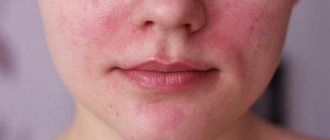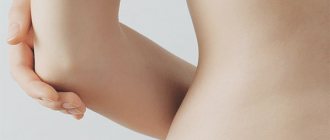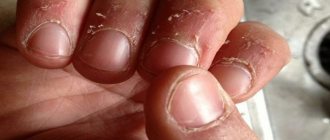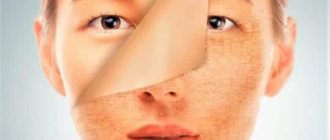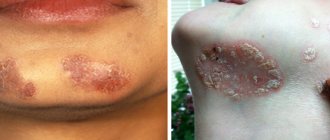There are many reasons that cause this unpleasant problem - the eyelids peel, itching, and severe burning appear. You should not treat alarming symptoms carelessly - a dangerous sign can portend more serious problems and even provoke a serious eye disease. Before starting treatment, it is recommended to determine which factor caused the peeling, try to eliminate it, and, if necessary, seek the help of a specialist. Timely use of medications or alternative medicine will allow you to effectively cope with the problem and prevent complications.
Useful tips for getting rid of flaking eyelid skin
To get rid of the problem, you need to carefully approach the question of what to do if the skin on your eyelids is peeling. First of all, determine the cause of this anomaly. Only after this, based on the results obtained, will it be possible to safely take certain measures.
So, general recommendations for getting rid of peeling skin of the upper eyelid are:
- Proper diet enriched with fresh fruits and vegetables.
- Avoiding stress and overwork.
- Using only high-quality decorative cosmetics.
- Purchase lenses and liquid for storing them only from trusted, licensed companies and pharmacies.
- Monitoring the cleanliness of facial skin in general.
- Avoiding eye strain.
- Avoiding contact with allergens that cause the eyelids to become red and flaky.
- Moisturizing dry eyelid skin with face creams or other cosmetics.
- Timely visit to the doctor for examination to identify various diseases. This step is especially important if all your efforts to get rid of itching and peeling of the eyelids have not been successful.
All kinds of medications are used to treat demodicosis, blepharitis, conjunctivitis or barley. In particular, this applies to eye drops and ointments.
If we are talking about herpes, due to which the skin on the eyelids becomes dry and peeling (at the last stage of the disease), then it can be cured with the help of tablets, creams or ointments (Acyclovir, Gerpevir, Zovirax, Acik, etc.).
Products and simple recipes to combat dry eyelids
With the problem of dryness, simple recipes can help you, as well as products that are almost always on hand.
, Sawed eggs (have beneficial properties), you need to use the yolks, they will perfectly help in nourishing and moisturizing the skin of the eyelids. - Sour cream with a high percentage of fat content, sour cream can be replaced with yogurt, yogurt should be without additives so as not to cause allergies. - Honey - healthy The properties of honey can be listed for a long time, so it is also an assistant in the fight for healthy eyelid skin.
, Olive oil (vegetable, peach, jojoba), banana and cucumber are also suitable for softening and nourishing. - Aloe is an excellent healer, as well as an assistant in the fight for beautiful and healthy eyelid skin. - Cosmetologists recommend after 36 years for prevention nourish the skin with grape seed oil.
, Preference in choosing a cream or care product should be given to products with collagen and hyaluronic acid. - Last but not least are cosmetic products that will help eliminate dry eyelids. It is necessary to use micellar water or hydrophilic oil, which in turn has a gentle composition, removes dirt, and does not remove moisture from the skin at all.
What are the causes of dermatitis on the eyelids?
Eyelid dermatitis is caused by a number of external or internal factors. Exogenous or external irritants affect the skin of the eyelids from the outside. Having penetrated the bloodstream, they become internal or endogenous. For the eye area, external or contact forms of dermatitis are more typical.
They may be associated with a local allergic reaction to cosmetics, medications, household chemicals, pollen, and animal hair. In addition to allergic reactions, the causes of periorbital dermatitis may include the following:
- bacterial and viral infections (herpes virus, bacterial infections, measles, scarlet fever, chickenpox);
- exposure to ultraviolet radiation or cold air;
- contact with the eye area of products containing active chemical elements;
- pathological functioning of the sebaceous glands as a result of activation of the Malassezia fungus;
- bites of blood-sucking insects.
When exposed to internal factors, the localization of inflammation varies widely, including the periorbital region. Their impact is often associated with the individual characteristics of the body. Common causes are the presence of chronic diseases (autoimmune reactions, metabolic disorders, endocrine pathologies), the use of medications and products containing allergens, and family history.
Eye dermatitis is quite common and occurs in 27% of cases.
Causes and provoking factors
Sensitive eyelid skin reacts negatively to any negative external influence. The epidermis turns red, cracks and peeling appear. Also, such symptoms can signal a malfunction of the internal organs. Most often, problems with the skin around the eyes are caused by the following factors:
- Allergic reaction;
- Use of low quality cosmetics;
- Eyelash mite causing demodicosis;
- Inflammatory lesion of the epidermis resulting from exposure to damaging factors;
- Failure to comply with personal hygiene rules;
- Fatigue of the organ of vision;
- Exposure to sunlight;
- Weathering;
- Spending a long time in front of a computer monitor;
- Lack of vitamins;
- Infectious disease;
- Dry eye syndrome;
- Fungus.
| Several factors can simultaneously cause peeling of the eyelid. To stop the disease, it is necessary to identify them all and eliminate them with the help of well-chosen therapy. |
Allergy
Most often, a negative reaction occurs upon contact with the following irritants:
- Plant pollen;
- Animal wool;
- Cosmetical tools;
- Products;
- Dust;
- Harmful fumes from household chemicals, etc.
To get rid of an allergic reaction, you must stop contact with the irritant.
Demodicosis
Self-medication should not be practiced under any circumstances; any medications should be prescribed by a doctor after a preliminary examination and a series of examinations.
You will learn how to protect yourself from demodicosis from the video.
Fungus
Failure to comply with basic hygiene rules and the use of other people's cosmetics leads to a person contracting a harmful fungus. In this case, you need to prepare for long-term treatment, since it is impossible to get rid of the “pest” in a couple of days.
Allergy
One of the most common reasons causing the development of anomalies. When a person comes into contact with an allergen, the eyes become very watery, and accordingly the skin becomes irritated and begins to peel off. The longer the body is exposed to the “pest”, the stronger the unpleasant symptoms.
Demodicosis
This ophthalmic disease is caused by eyelash mites. Most often it appears in autumn and spring. The cause of the damage is a weakened immune system; pensioners are also at risk. Mites get under the skin of the eyelids and begin to feed on hair follicles and can affect the sebaceous glands. The first symptom of the disease is loss of eyelashes and inflammation of the eyes, increased lacrimation and peeling of the skin under the eyelids.
Fungus
Help from traditional medicine
If the cause of the anomaly does not lie in a serious illness or you simply don’t have time to visit the clinic, try using the gifts of nature and grandma’s recipes. Some of them are excellent substitutes for medications and successfully fight the disease. However, despite their effectiveness, there is no need to abuse traditional medicine. Before using any recipe, consult your doctor.
To moisturize dry skin, use melt water and wash your face with it every morning; herbal decoctions or tar soap are also suitable for this purpose. Tinctures from medicinal plants are an excellent option for compresses. The most commonly used plants are calendula, chamomile, and St. John's wort. At the stage of regeneration of the epidermis, you cannot use string and celandine, as they are very drying
Use the latter with extreme caution, as it is poisonous.
To prepare a medicinal decoction, no special knowledge or skills are required. Take a tablespoon of herb, pour a glass of boiled water and keep in a closed container until the infusion has cooled. Next, strain it and use it in the following way:
- As lotions. Soak a cotton pad in the liquid and apply to the affected organ of vision for half an hour;
- For washing. Soak a cotton swab well in the solution and wipe the eye in the direction from the nose to the temple;
- For rinsing. Dilute the broth with boiling water in a ratio of 1:5, and irrigate your face with it every time after washing.
Several proven traditional medicine recipes will also help get rid of peeling.
Camomile tea
Take one tablespoon of dried chamomile flower and pour boiling water over it. After the composition has infused, strain it. Soak a cotton pad in the liquid and apply to damaged eyes. If the infusion is diluted with water, it can be used as eye drops. It relieves fatigue, relieves dryness and irritation.
Tea brewing
They help with visual fatigue and as therapy for a variety of ophthalmological pathologies. It is better to use loose leaf tea, but you can opt for bagged tea. The brew should be very strong, soak the discs in it and apply for about fifteen minutes.
Aloe juice
Cut the aloe leaf and place it in the refrigerator, this will help achieve the desired consistency. Within seven days, the juice is saturated with enzymes and becomes liquid. Lubricate damaged skin with it. The juice moisturizes well, eliminates redness and itching, and restores the epidermis.
Symptoms
The appearance of peeling areas of skin around the eyes may be the only symptom of problems in the body, but most often it is accompanied by other complaints. These include:
- loss of eyelashes and eyebrows;
- changes in skin color and texture (redness, strengthening or weakening of natural pigmentation, skin pattern);
- the appearance of blisters or other elements of the rash;
- the appearance of purulent or mucous discharge from the eyes;
- swelling of the skin.
The manifestation of these clinical signs will help the doctor determine the nature of the disease and its causes, therefore, when visiting medical institutions, you need to indicate in detail how and after what the symptoms bothering the person developed.
With allergic manifestations, both eyes are usually affected, causing severe swelling, watery eyes and a runny nose. Often these signs appear after eating certain foods or during the flowering of certain types of plants. Typically, adults already know the substances that cause their corresponding complaints.
When affected by some skin mites, individual itchy and flaky areas of skin appear near the eyelashes. Symptoms usually appear in the autumn and spring months or after a decrease in immunity. They can go away on their own without treatment.
Blepharitis (inflammation of the ciliary edge of both eyelids) can be a consequence of the development of pathogenic microorganisms (viruses, fungi, bacteria). It may appear in one or both eyes, accompanied by pain, purulent or mucous discharge from the eyes, and redness of the skin. Sometimes the disease spreads to the mucous membrane of the eye itself, causing conjunctivitis.
Peeling of the skin in the eyelid area can occur after a chemical burn or exposure to ultraviolet radiation, for example, in a solarium or when welding metals. It is usually accompanied by eyelid soreness, sensitivity to bright light, and redness. In more severe cases, blisters with transparent contents may appear on the eyelids.
With hormonal problems, the appearance of skin flakes may be accompanied by loss of eyelashes and changes in pigmentation. Typically, such manifestations of diseases do not cause severe itching or pain, but they can cause psychological discomfort, especially in women.
Symptoms caused by low-quality cosmetics or false eyelash glue are usually immediately associated with the use of these products and worsen after repeated application to the skin. This can cause contact dermatitis on the eyelids or allergic reactions.
It is not always possible to independently determine the cause of peeling skin near the eyes, so it is better to consult a dermatologist or ophthalmologist. Only a doctor can correctly assess all the existing clinical signs and determine the disease that caused them.
Precautionary measures
Sometimes we ourselves provoke increased dryness of the skin around the eyes. © iStock
It is often our own fault that the skin of the eyelids becomes extremely dry: by ignoring its characteristics and needs, we treat it inappropriately. Remember what you absolutely cannot do.
Wash off makeup with soap. The pH level and detergent base of the soap, as well as any products not created for eye makeup removal, are not suitable for this vulnerable area. She will respond with at least peeling.
Use face cream. Facial products are not suitable for the eye area due to its physiological characteristics. It is thinner, prone to swelling, plus it is in close proximity to the mucous membrane of the eye, which means there is a high risk of allergies and irritation. Even if you have already tested your face cream or serum in this area and nothing bad happened, do not relax. The reaction may not occur immediately, and dealing with its consequences will be more difficult.
Rub your eyes with your hands or a towel. This is an unacceptably rough manipulation for fragile skin with a weakened hydrolipid film.
Use of medications without indications. Buying eye drops for yourself without a doctor's prescription is not a good idea. Be careful with products that stimulate eyelash growth. Perhaps the eyelashes will indeed become longer, but what is the point if they “decorate” red eyes swollen from an allergic reaction?
Causes of peeling eyelids
If the skin on your eyelids is peeling, there can be many reasons for the manifestation. Some of the factors that provoke the problem are quite harmless, and you can cope with them on your own. There are also more dangerous reasons for health, the elimination of which will require the help of doctors.
Some of the most common causes of redness and flaking of the skin include:
- allergic reaction to external irritants (low-quality or inappropriate cosmetics, frost, wind, ultraviolet radiation);
- the use of synthetic-based cleansers;
- age (in old age, peeling occurs more often);
- regular work at the computer;
- viral, infectious diseases;
- constant scratching of the eyes;
- severe fatigue;
- improper functioning of the sebaceous glands (women with dry skin are more likely to suffer from the problem than women with oily dermis);
- low humidity in the room where you have to stay for a long time;
- errors in choosing or wearing contact lenses;
- using too harsh a liquid to wash your face.
Some of the most dangerous factors that provoke peeling are diseases. Demodicosis is one of the most common. Infection with a subcutaneous mite can lead to loss of eyelashes and the release of a thick liquid with an unpleasant odor from the skin.
Viral diseases and fungal infections also often lead to problems with the dermis. Itching, peeling, and the appearance of small bubbles with clear liquid are only part of the unpleasant symptoms that will have to be eliminated with the use of pharmaceutical drugs.
If you can’t determine why the skin is red, or what factor caused the unpleasant problem, it’s better to go to the doctor. It is recommended to begin treatment with pharmaceutical drugs or home remedies only after an accurate diagnosis - improper use can cause dangerous vision pathologies.
Where to go?
The appearance of the first signs of damage to the epidermis around the eyes is not a reason to panic, but you should not hesitate to visit a doctor. Do not forget that the skin of the eyelids is very thin and delicate, and any injury to the organ of vision can lead to irreversible consequences.
First of all, visit an ophthalmologist and a dermatologist; in some cases, a consultation with an allergist is required.
You should not always hesitate with treatment and visits to doctors. There are several reasons to go to the doctor if you have to deal with an unpleasant manifestation. Among them:
- dry skin on the eyelids does not respond to home remedies, peeling continues to develop rapidly and affect healthy tissue;
- reddened eyelids, which are accompanied by increased production of tears;
- the skin is very itchy and covered with a profuse rash;
- ulcers appear on the dermis, secreting a viscous liquid with an unpleasant odor;
- bleeding areas form;
- eyelashes begin to fall out.
In no case should you try to cope with the problem yourself - use gentle home cosmetology products or drugs from a pharmacy. Delay in contacting a specialist can lead to dangerous complications and the development of serious illnesses. It often happens that the disease is already lurking and waiting for the right hour, indicating itself with an alarming signal - peeling of the skin of the eyelids.
If the skin above the eye is peeling, you should not expect it to go away on its own. Neglect of alarm signals will lead to irreversible consequences, so it is better not to hesitate. If the manifestation is not dangerous, you can cope with it with home remedies, otherwise you will have to resort to medications that will quickly eliminate the unpleasant symptom.
If the upper eyelid itches and peels, then you should not ignore this signal from the body. Most likely, it arose for a reason, and indicates certain problems with eye health.
Be that as it may, you should not self-medicate. In order not to harm yourself, you first need to establish the causes of peeling skin on the eyelids, and only then begin to act actively.
How to deal with peeling skin around the eyes
You can remove redness and flaking using moisturizing creams or folk remedies. Changing decorative and skincare cosmetics, a fortified diet and the “correct” consumption of water can also help. But if the reasons are not external, but internal, the problem will arise again.
So, the basic principles regarding proper care of the skin around the eyes are:
- Regularly perform masks from fresh fruits and vegetables, among which special preference should be given to cucumbers, tomatoes, bananas, and lemon. These products not only eliminate and prevent flaking of the skin under the eyes, but also refresh it, making it more elastic and rosy.
- Rubbing the skin with ice cubes.
- Cleansing the epidermis with scrubs.
- Using soft cleansers (gels, cream soaps).
- Avoiding the use of antibacterial soaps, which dry out the skin, causing the skin to peel and peel before the eyes.
- Frequent walks in the fresh air.
- Drinking enough fluid to replenish the water balance of the epidermis.
- Careful monitoring to ensure that the immune system fully copes with its functions. If the skin under the eyes is peeling due to weakened immunity, it is imperative to address this problem.
- Fight against vitamin deficiency.
If inflammation of the skin around the eyes causes a lot of discomfort, you can try to relieve it with medicinal lotions or wiping with ice. So, decoctions for these procedures should be prepared from medicinal plants such as:
- Pharmaceutical camomile. It has an antiseptic, sedative and analgesic effect.
- Calendula (marigold flowers) is a medicinal plant that has antiseptic, bactericidal, and anti-inflammatory effects.
- St. John's wort.
- Peppermint. This medicinal plant refreshes the skin and gives a feeling of coolness, which the epidermis especially needs during various pathological processes occurring in it.
- A series that has anti-allergic, relieving irritation, itching and inflammation effects.
To prepare a decoction, you need to take 5-6 g of the selected dry medicinal herb, pour boiling water over it and put on fire. After 6-7 minutes, remove the mixture from the stove, cool, then squeeze out the cake and filter through a sieve or cheesecloth.
Soak a cotton swab or clean soft cloth in the prepared broth, then apply to the sore spots. This medicine perfectly relieves inflammation and peeling of the skin on the eyelids and around them.
In addition to lotions, such a decoction can be frozen by forming ice cubes from it. They can be used for rubbing, which show excellent results if the skin near the eye is peeling.
In addition to this means of combating dermatological problems, you can resort to using another highly effective method - a compress of finely chopped fresh parsley leaves. Apply the paste to problem areas, hold for a quarter of an hour, then carefully remove with a cotton pad soaked in warm water.
If these procedures do not help, and the skin under the eyes still peels, what should you do in this case? First of all, stop panicking and seek help from a doctor. In this case, you don’t need to worry, but act, so don’t hesitate
It is especially important to consult a qualified specialist if the reason why the skin around the eyes is peeling has not been established.
Be sure to review your makeup bag. Perhaps it is in it that you will find the thing that became the culprit of all your troubles. If the problem actually lies in a weak immune system, be sure to undergo a course of therapy with immunomodulators.
This can be a tablet drug Ismizhen, herbal drops Sinupret or Imupret, homeopathic remedy Aflubin, etc. The course of treatment should last at least 3 weeks.
If, during this period of time, or after the end of therapy, the skin in the corner of one or both eyes does not stop peeling, it means that the cause of this anomaly was determined incorrectly.
Vitamin deficiency is another serious problem that must be combated in every possible way. What to do if the skin around the eyes peels precisely because of this anomaly? The answer is obvious: get rid of the problem immediately! To combat it, various vitamin complexes are suitable, as well as a menu enriched with cereals from different types of cereals, vegetables, herbs, fruits and nuts.
Prevention of the problem
It is not possible to completely prevent a dangerous manifestation even with preventive measures, but it is quite easy to partially reduce the danger. The eyelids often peel and itch as a result of careless hygiene or improper care of the skin, so it is better to adhere to the basic recommendations.
Strict adherence to the following rules will partially prevent trouble:
- use only high-quality cosmetics (preferably natural), and be sure to completely wash off makeup before going to bed;
- do not rub your eyes with your hands, especially dirty ones;
- for washing, use only preparations suitable for your derma type (if necessary, consult a cosmetologist about what to give preference);
- regularly carry out procedures to soothe the eyes, use herbal decoctions (chamomile, green tea);
- change your diet, introduce vegetables and fruits.
Inflammation of the eyelids treatment
This inflammation of the eyelids is often caused by blepharitis. If eyelid inflammation is not treated at the very beginning, you will have to suffer from this disease for many years. If inflammation of the eyelids is left untreated for a long time, vision may deteriorate.
This is the most common disease that accompanies:
- infectious
- viral
- allergic diseases, but this disease can develop independently
What to do first:
- Proper eyelid hygiene is very important
- it is necessary to remove the detachments that have appeared on the eyelid with a swab or damp cloth
- if these detachments have become rough, they need to be softened with a special liquid or eye cream
- prepare a decoction of herbs and wash the sore eyelid and eye
In case of inflammation of the eyelids, treatment should be immediate. It should be traditional, but folk remedies also help very well. Never rub your sore eyes with your fingers.
- constantly strengthen your immune system
- don't sit at the computer for a long time
- When watching TV or sitting at the computer, warm up your eyes
- lead an active lifestyle
- avoid stress
- eliminate cigarettes and alcohol
Traditional treatment of eyelids
Traditional treatment of eyelids is possible and recipes can be selected that are very effective and easy to prepare. There are several folk recipes that can help treat eyelids.
Recipes:
1.
You can prepare an aqueous infusion of calendula, chamomile, clover, plantain leaves or dill seeds based on blue cornflower flowers. Soak two cotton pads in this solution and place on your eyelids for about ten to fifteen minutes.
2.
Tea bags can relieve inflammation and refresh the skin of the eyes. Try to apply them on your eyelids as often as possible.
3.
For inflammation of the eyelids, prepare a decoction of cumin or a decoction of wheat cereal. Moisten cotton pads with the resulting solution and apply to the eyelids.
If the traditional eyelid treatment methods that are given to you do not help relieve inflammation within two weeks, continue treatment with a specialist.
You should also consult a doctor if:
- the appearance of sharp pain in the eyes
- changes in visual acuity
- when wounds or ulcers form in the eyelid area
Good hygiene is the basis of eyelid treatment. There can be a variety of problems that can sometimes cause damage to vision. In order not to lead to serious complications, eyelid treatment must be correct and timely.
Depending on the complication, the doctor may prescribe antibiotics and other medications. The main thing is to apply on time and under no circumstances delay it. Warm compresses made from strong tea leaves. This will cleanse your eyes of pus and relieve inflammation.
Please leave your review if you liked the article
Your opinion is very important. This will help you write articles that are more interesting and useful.
I will be eternally grateful if you share the information with your friends and click on the social network buttons.
Be healthy and happy.
Why do the eyelids peel?
There are many options for the appearance of scales on the skin; their rash can be triggered by both illness and an innate tendency to dry skin.
Reasons why the eyelids peel and itch
There are several main reasons influencing this phenomenon:
- allergic rashes (reaction to animals, flowering plants, food, cosmetics and medications, dust, etc.);
- fatigue of the visual organs;
- fungal, viral, bacterial diseases (herpes, papillomas, etc.);
- eyelash mite (demodex);
- skin dermatitis - acute allergic manifestations to various factors;
- blepharitis - inflammation of the edge of the eyelashes that occurs against the background of decreased immunity;
- dysfunction of the sebaceous ducts around the eyes;
- atopic dermatitis is a chronic non-contagious allergic disease;
- increased dryness of the skin.
Dryness of the eyelids as a cause of their peeling
Bright sun, frost, windy weather, poor environmental situation in the place of residence can affect the condition of the skin of the eyelids. In addition to natural phenomena, the skin defect is significantly affected by stressful situations, which the life of a modern person cannot do without, as well as too little sleep, poor diet, poor cosmetics, lack of care and bad habits.
Diseases
A number of skin problems, accompanied by itching and swelling, can provoke this phenomenon:
If you notice dryness and flaking of the eyelids, first of all you need to provide good care - use moisturizing and soothing products.
If the problem is not poor nutrition or lack of sleep, then you should seriously concern yourself with your health and consult a doctor - suddenly your body is affected by an unpleasant disease.
Associated symptoms
In most cases, peeling is not the only sign that causes discomfort to a person. He may also be concerned about:
- increased lacrimation;
- swelling of the tissues around the eyes;
- fragility and loss of eyelashes;
- the appearance of photophobia;
- purulent discharge;
- pain in the eyes.
Peeling of the skin around the eyelids is accompanied by additional symptoms. Some of them are very specific and help to easily identify the cause that triggered the development of the anomaly.
Typical accompanying symptoms:
- Unbearable itching;
- Redness of the epidermis around the eyes;
- Swelling of the eyelids;
- Intolerance to bright light;
- Increased tear production;
- Pain in the eyes;
- Eyelashes break and fall out;
- Redness of the sclera is observed.
| Discharge of pus may signal the development of conjunctivitis; in this case, before starting treatment, it is necessary to establish its type (allergic, bacterial, etc.). |
In most cases, peeling eyelid skin is accompanied by a number of other symptoms. Some of them can be very specific and directly indicate the cause of the problem. After analyzing them, you can find out in which direction to carry out treatment.
The most characteristic accompanying manifestations are:
- severe unpleasant itching;
- the skin around the eyes may become red;
- swelling of the eyelids;
- fragility and loss of eyelashes;
- redness of the conjunctiva and sclera;
- cutting sensations in the eyes;
- intense lacrimation;
- aversion to bright light.
Eyelash loss most often indicates mite infestation. But the appearance of blisters is a sign of a herpes infection. Purulent discharge may be a sign of conjunctivitis, but its nature must be further determined. It can be allergic, bacterial, viral or fungal.
If the problem does not disappear for more than 3 days, new symptoms appear or existing ones worsen, you should immediately seek medical help.
It will also be useful: Colds on the face: a serious obstacle to perfection
The causative agent of the disease is determined by the results of skin scrapings or sebaceous duct secretions. When infected by a mite, itching, swelling is observed, the skin of the eyelids peels, scales appear on the eyelashes, and loss of eyelashes is observed. Often the process spreads to neighboring areas of the face.
Therefore, the answer to the question of why the skin between the eyebrows peels may also be demodicosis.
| Discharge of pus may signal the development of conjunctivitis; in this case, before starting treatment, it is necessary to establish its type (allergic, bacterial, etc.). |
Treatment
The main method of treating flaky eyelid skin is to follow hygiene rules. Any disease is very difficult to cure if there are particles of pollution or cosmetics on the damaged surface of the epidermis. Usually, when treating such diseases, strict restriction of eye makeup is prescribed.
The following groups of medications are used as drug therapy:
- Antimicrobial, antifungal and antiseptic agents (Erythromycin ointment, Clotrimazole, Chlorhexidine).
- Agents that soften and heal damage (Blefarogel, Actovegin in gel form, Dexpanthenol).
- Hormonal ointments (Advantan, Hydrocortisone ointment).
- Antihistamines (Claritin, Suprastin, Cetirizine).
Any treatment should be prescribed only by a doctor, since the eye area requires qualified intervention. This will avoid side effects that may affect the patient's vision or appearance. Without identifying the cause of the symptoms that have developed, it is pointless to treat them, so you should not look for similar symptoms on the Internet and prescribe any medications yourself.
Slanko Anna Yurievna
Dryness of the top layer of skin (epidermis) is most often caused by a lack of moisture. Cellular metabolism slows down, skin creases - wrinkles - form. Additional symptoms such as itching, redness, swelling are a reason to consult a doctor
It is important to preserve beauty and prevent complications of a possible disease
Causes of peeling eyelids
The most common factors that can be used to explain why the skin on the eyelids peels are:
- allergies or irritation of the epidermis caused by the use of low-quality or expired eye cosmetics;
- seasonal allergies;
- age factor (so-called dry eye syndrome);
- respiratory diseases;
- dry skin;
- hard or chlorinated water;
- contact lenses that were not selected in accordance with all standards, or were stored incorrectly;
- too dry air in the room, where most often there is a person who experiences redness and peeling of the upper eyelid (one or both);
- eye fatigue;
- bad habit of constantly scratching your eyes;
- prolonged sitting at a computer screen;
- using aggressive products to wash or cleanse the skin of the face.
In addition to these factors, peeling and redness of the eyelids can be the result of a foreign object getting into the eyes. In this case, the person will also experience tearing, itching and burning of the eyes. Such irritation of the mucous membrane of the visual organ cannot but affect the condition of the skin of the eyelids.
If the cause of this phenomenon is not associated with serious diseases, then peeling of the skin on the eyelids will go away on its own in a few days. However, if there is any pathology, you should consult a doctor for advice. A thorough examination and modern diagnostic methods will help determine the exact cause of the anomaly.
Pathologies that can lead to peeling of the upper eyelid are:
- Demodicosis, the development of which is caused by hair mites. It can also be diagnosed at home. So, with this disease, the patient experiences redness and flaking on the eyelids, foamy liquid is released from the eyes, and itching and burning are felt. Eyelash loss, increased lacrimation and severe redness of the whites of the eyes are possible.
- Blepharitis. Pathology often develops in people with a weak immune system, as well as with chronic conjunctivitis, vitamin deficiency, and gastrointestinal diseases. Symptoms of the disease can manifest themselves as peeling of the skin of the eyelids, heaviness in the eyes, photophobia, swelling and hyperemia of the eyelids. When the eyelids begin to peel intensely, eyelash loss occurs. There is no need to hesitate: blepharitis is a dangerous disease that can become chronic.
- Conjunctivitis is an eye disease in which there is redness of the whites of the eyes, itching and the presence of purulent discharge. The eyes become swollen and photophobia appears. If the issue of treatment is not addressed in time, the patient’s eyelid skin will begin to peel, not only the upper, but also the lower.
- Barley. This pathology can develop against the background of incompletely cured or often recurrent conjunctivitis. It manifests itself through redness of the eyes and the formation of a lump with pathological contents on the surface of the eyelid (or on its mucous membrane). If the eyelid is peeling, watery eyes and a headache appear, rest assured that your fears are correct – it’s a stye.
- Fungal infections. If the skin on the eyelids is red and peeling, especially in areas where there is hair, the cause of the abnormality may be a yeast fungus. The manifestations of the disease cannot be ignored, as it can be transmitted to others.
- Hormonal imbalance. This pathology can manifest itself in different ways. If, due to an allergy, red spots appear on the eyelids that itch and flake, then with a hormonal imbalance, only the rejection of dead cells of the epidermis is observed. This phenomenon is also not considered normal, but you should not take hormonal medications at your own discretion - leave the choice of medication to a qualified physician so as not to harm yourself.
- Herpes virus infection is another common reason why the skin on the upper eyelid peels. In this case, the epidermis becomes dry and red, and the patient develops blisters on the surface of the eyelids filled with infected fluid. They lead to itching, burning, and painful sensations.
It is extremely rare that the skin on the eyelids peels and itches, indicating the presence of:
- diabetes mellitus type 2;
- liver dysfunction;
- gastrointestinal diseases.
If you cannot independently identify the causes of dry eyelid skin and its peeling, this can only mean that some pathological processes are occurring in the body. The sooner they can be detected, the less dangerous and unpleasant the consequences for human health will be.
Possible reasons why the upper eyelid may peel, itch, turn red, and even swell
If problems arise with the organs of vision, when the eyelids itch outside or inside the eyes, with the feeling of a foreign object getting there, you should not panic, do not try to get rid of the discomfort with the first drops that come to hand, and even more so comb the eyelid - there is a high probability of getting it under the eyelid additional infection.
Medical therapy
Treatment is prescribed depending on how quickly and correctly the diagnosis was made and the reason why the eyelids itch was determined. Treatment methods are as follows:
- For allergic processes, treatment consists of taking antihistamines, which eliminate the body's reaction to the allergen and the production of histamine. These can be tablets, ointments, gels, intramuscular, intravenous injections.
- Blepharitis can be treated by placing antibacterial drops in the affected eye. Additionally, the doctor prescribes NSAID-based ointments to prevent the eyelids from itching, and rinsing the eyes with diluted boric acid and other antiseptic liquids.
- Treatment of demodicosis includes taking antibiotics, to which the demodex mite is sensitive. However, there is a possibility that treatment will take a long time to achieve an effective result, since Demodex may be resistant to one or another type of antibiotic. In addition, ophthalmologists prescribe immunostimulants to boost immunity.
Folk remedies
Traditional medicine methods in situations where the eyelids itch can complement the main treatment. You should not count on the fact that with their help you can get rid of the disease once and for all. If your eyelids itch, tincture of lily of the valley will help get rid of the itching. You need to take crushed flowers and leaves of the plant in the amount of 1 tsp.
Peeling of the upper eyelid is a rather unpleasant process, because flaking skin particles spoil the appearance, reduce self-esteem and performance. Very often peeling is accompanied by other symptoms:
- pain in the eyes;
- redness of the mucous membrane;
- swelling;
- pain;
- formation of pustules on the eyelid.
Such signs cannot be ignored; in a neglected state, this can affect visual acuity. Before you do anything, you need to find out the cause of the skin change. You should not engage in self-diagnosis; you should urgently visit an ophthalmologist.
The cause of peeling eyelids may be:
- allergic reaction to food, cosmetics, plants, animals or dust. In this case, peeling is preceded (or accompanied by) a red spot, swelling, and copious release of tear fluid;
- dry eye syndrome, which usually occurs in older people;
- respiratory viral infections;
- using low-quality, inappropriate eye cosmetics or expired products;
- dry and naturally sensitive skin;
- chronic fatigue, lack of sleep and prolonged work at the computer;
- washing with hard tap water using aggressive agents, such as regular soap;
- long stay in a room with dry warm air;
- using contact lenses for longer than the recommended time or being allergic to the solution for storing them.
These factors do not pose a serious threat to health and are easily eliminated.
Peeling can also occur when sand, insects or other small objects get into the eyes. At first there is severe itching and tearing. Peeling in this case is a reaction to constant skin irritation.
Peeling of the skin near the eyes can be one of the manifestations of certain pathologies:
- Demodecosis.
A dermatological disease that occurs when infected with hair mites. The pathology is accompanied by severe discomfort, redness of the whites and severe itching. In severe cases, foaming fluid is released from the eyes and eyelashes fall out. Every person has microscopic mites; pathological changes occur when the immune system is weakened.
- Fungal infections.
They manifest themselves as itching and peeling on the scalp and eyelids. Infection occurs through contact with infected people, animals, or after prolonged use of antibiotics.
- Viral diseases (most often herpes).
Very often they affect only one eye, but are easily transferred to the healthy one by touching. Viral infections are manifested by redness and dryness of the eyelid, subsequently small blisters filled with liquid form on the skin.
- Conjunctivitis.
Viral or bacterial infections of the eyes, the symptoms of which are redness of the whites, photophobia, tearing. In advanced cases, pus is released, sometimes in large quantities.
- Barley.
A painful bacterial lump on the eyelid caused by inflammation of the sebaceous ducts. The disease develops acutely, initially there is discomfort, itching and lacrimation, headaches, and a foreign body is felt in the eye. Gradually the size of the stye increases, after some time it ripens and pus comes out.
- Blepharitis.
A pathological condition of the eyes that occurs in people with weak immunity or gastrointestinal disorders. The eyes are constantly itchy, watery, and may become red and swollen. At the last stage, severe peeling of the eyelids and loss of eyelashes are observed.
Sometimes peeling of the eyes appears due to serious human diseases: cirrhosis, ulcers, diabetes mellitus, tuberculosis.
Redness of the eyelid skin and peeling cannot be considered as a cosmetic defect that can be eliminated with external means.
This should be done by a qualified specialist who will first find out the cause of this pathology and prescribe appropriate treatment.
Most often, this phenomenon is seasonal and occurs during the flowering period of various plant species.
Allergies can also be caused by:
- Food;
- creams, lotions, masks, decorative cosmetics;
- dust;
- animal hair and dander;
- insect bites;
- household chemicals;
- medications.
In some cases, it is not possible to independently identify the factor causing the development of an allergic reaction. To do this, skin tests are carried out in the clinic, making it possible to identify the allergen with 100% probability.
When caring for the skin around the eyes, you should adhere to the following rules:
- never use cosmetics that have expired;
- do not use scrubs, peelings;
- do not wipe this area with tonics containing alcohol;
- choose cosmetics according to age and skin type;
- follow the rules for storing cosmetics;
- apply products to the skin only with clean hands;
- monitor the cleanliness of brushes, sponges, brushes and other instruments that come into contact with the eyelid area.
Important to remember! Eyelid skin care products should be used strictly individually.
Even if you choose the right products for the care of sensitive skin around the eyes, you can cause the opposite effect if they are used incorrectly.
It is prohibited to do the following when caring for the skin around the eyes:
- leave decorative cosmetics on your face overnight;
- rub the cream or gel into the skin of the eyelids;
- use masks or compresses more often than indicated in the instructions;
- Use toilet soap or shower gel to remove cosmetics.
If the cream does not have a dispenser, then you should take it from the jar using a special stick, spatula or spatula, which must be thoroughly wiped or washed after each use.
This will help minimize the risk of bacteria and pathogenic fungi developing in the cream.
Apply the cream or gel to the eyelids by lightly touching them with your ring fingers, in the direction from the outer to the inner corner of the eye.
Remove eye makeup with gentle movements using a product intended for this purpose, applied to a cotton pad or swab.
Attention! If, after applying a care product or decorative cosmetics, a feeling of discomfort, burning, itching or redness of the skin around the eyes occurs, you should quickly wipe it off with a cotton pad, rinse with clean water and take an antihistamine tablet (Diazolin, Suprastin, Tavegil) ).
Fungal infections
Redness and peeling of the eyelids can be caused by fungal diseases such as:
- seborrhea;
- trichophytosis;
- favus.
According to statistics, the most common cause of peeling eyelid skin is seborrhea, caused by the opportunistic fungus Malassezia.
Being constantly present on a person’s skin, it does not manifest itself until a sharp decrease in immunity occurs as a result of illness, severe stress or other factors.
If you have redness of the eyelid skin or peeling, do not postpone visiting an ophthalmologist and further treatment.
During this period, the fungus begins to multiply intensively, affecting the sebaceous glands, disrupting the production of their secretions and leading to inflammation of the skin around the eyes.
The main symptoms of the disease are:
- redness of the skin of the eyelids with pronounced peeling;
- the appearance of round, shiny spots;
- a burning sensation in the eyes;
- presence of small bubbles;
- eyelash loss.
Periodically, the blisters burst, serous exudate flows out of them, which, when dried, forms a yellowish crust.
Trichophytosis is caused by fungi of the genus Trichophyton.
Parasitizing the skin of the eyelids, they cause folliculitis, manifested by:
- swelling;
- hyperemia;
- severe itching;
- the presence of small pustules covered with crusts;
- a clearly visible coating of spores on the eyelashes;
- eyelash loss or breaking off.
Small round lesions in the form of craters are clearly visible on the skin, in the center of which there are numerous scales. Lack of treatment leads to the development of conjunctivitis.
The causative agent of favus is the fungus Achorion Schünleini. The pathological process is characterized by the appearance of reddish papules and scales near the hair follicles on the skin of the upper eyelid.
As the disease progresses, the papules turn into yellowish crusts and disappear. Doctors record numerous cases of self-recovery.
Increased sensitivity of the skin around the eyes is due to the lack of a subcutaneous fat layer, which is recognized to perform a protective function.
Therefore, redness and peeling of the eyelids can be caused by unfavorable environmental factors, which include:
- direct exposure to ultraviolet (sun) rays;
- low temperatures;
- sudden temperature fluctuations;
- severe air pollution;
- wind;
- dry air.
Diagnostics
If eyelid dermatitis is suspected, a detailed diagnosis is necessary to identify the type of pathogen. The treatment regimen and tactics will depend on this. A whole range of studies are being carried out.
An important point is the external examination and collection of anamnestic data. A detailed history provides the doctor with the necessary information and serves as a basis for making a diagnosis. An external examination of the eye using a slit lamp helps determine the presence of edema, the degree of hyperemia, and the nature of the rash. The severity of a particular symptom indicates the type and nature of the course of the disease. To clarify the diagnosis, a number of laboratory tests are necessary:
- A general blood test is carried out in order to diagnose the presence or absence of an inflammatory process; the nature of the infectious eye lesion is determined by the shift in the leukocyte formula.
- An ELISA test (enzyme-linked immunosorbent assay) allows you to determine the intensity of the inflammatory reaction.
- An increased level of immunoglobulin E in the blood serum indicates that eyelid dermatitis is of an allergic nature.
- Blood sampling for provocative tests is done to identify the allergen.
- A PCA or polymerase chain reaction test helps determine whether the viral load is excessive when dermatitis is suspected of being infectious.
- Scraping of biomaterial for subsequent histological examination is carried out in order to confirm or exclude the presence of seborrhea or other fungal disease.
Differential diagnosis of eyelid dermatitis is also necessary, since there are diseases with similar symptoms - toxicoderma, erythroderma, eyelid eczema. Their treatment regimens are different.


